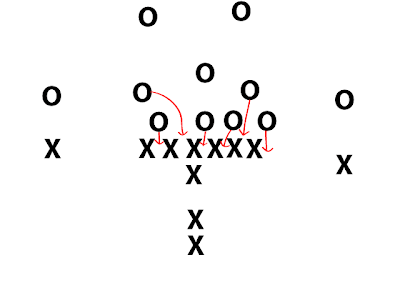 Michigan Defensive Coordinator Scott Shafer may be one of the least popular men in Ann Arbor right now, as the Wolverines’ defense is reaching historically bad levels. Though I defended the play of the defensive unit last week, the performance against Purdue was bordering on inexcusable. However, the main recipient of much (often idiotic) blame has been Scott Shafer. Much of the knowledge form this post comes from the all-knowing gsimmons85, without whom I’d know even less about football than I currently do. I assume he’ll be here to comment on this post, so if you have any specific questions that I can’t answer, fire away.
Michigan Defensive Coordinator Scott Shafer may be one of the least popular men in Ann Arbor right now, as the Wolverines’ defense is reaching historically bad levels. Though I defended the play of the defensive unit last week, the performance against Purdue was bordering on inexcusable. However, the main recipient of much (often idiotic) blame has been Scott Shafer. Much of the knowledge form this post comes from the all-knowing gsimmons85, without whom I’d know even less about football than I currently do. I assume he’ll be here to comment on this post, so if you have any specific questions that I can’t answer, fire away.
Playing Only 3 Defensive Linemen
The argument is as follows: Michigan has good defensive linemen and bad linebackers/safeties, so you should want to get as many d-linemen on the field as you can, and minimize the number of linebackers and saefties. Au contraire, mon ami. If you have bad defensive backs, you should actually want to play more of them. Why is this? You’re expecting bad players to make mistakes. Therefore, there is somebody to step in and cover for, say, Stevie Brown’s mistake if there are three safeties playing. In most games this year (and the Purdue game in particular – more on that in a second), Michigan would get the same amount of pressure on the quarterback whether there were 3 or 4 defensive linemen in the game. In that instance, why “waste” a player on the field by putting in another end who won’t increase the pressure at all, at the expense of allowing the secondary to be exposed.
Completely Switching Defensive Schemes against Purdue
I still don’t believe that this was all Shafer’s decision, as he’s never really run the 3-3-5 extensively. However, what the headman says goes, and the base defense was indeed changed in the Purdue contest. This was also to get the most help possible for the secondary, as they would presumably need it against a pass-heavy team. One final factor to take into account in this game was the base offense of Purdue. As a spread team, their blocking assignments are much easier when facing an odd front.
Playing Soft Coverage on the Corners
Michigan doesn’t have the cornerbacks to play tight man coverage. End of story. If they were trying to do this (despite their inability), we;d see teams going deep with much greater frequency and success against this team. If Morgan Trent and Donovan Warren were lined up a yard off the line of scrimmage, they would get blown past by opposing wide receivers a lot of the time. This would leave our questionable safeties to save the play, which we certainly don’t want, at least this year. In the future, when Shafer has more of his recruits in position, tight man coverage with a reliance on the safties to prevent big plays will be much more of an option.
Too Much Zone Coverage
This is a similar reasoning: Michigan can’t really cover that many teams in man. Boubacar Cissoko and Donovan Warren are the only ones on the team that are even particularly close to being able to do so. As much of a liability as John Thompson can be in pass coverage, do you really want to see him lined up in man coverage with a tight end or running back? If your answer to that question is anything other than “no,” you are wrong. Unless you are a fan of the opposing team, in which case your answer is “Yes, yes, a thousand times yes.”
Lack of Player Fundamentals
This may be one of the few legitimate gripes against the defense this year. Many of the players lack fundamentals, particularly in the “tackling” department. However, how much of this is the fault of the coordinator? Next to none. Some of the players (i.e. Brandon Graham) are trying to do more than they should to make plays, since they know that their teammates can’t necessarily be counted on. This causes them to miss their assignments. Other players are simply not good physical matches for the positions they are playing at the Division-I level (i.e. Charles Stewart). Even if the coaching is poor, how much of that is on Shafer, and how much rests at the feet of their position coaches? Nearly all. Bruce Tall hasn’t been a defensive line coach since 2002. Jay Hopson spent the last three seasons coaching DBs. With the linebackers and safeties the primary liabilities on Michigan’s defense, they may be at least as culpable as Shafer.
The future is brighter for the defense, however. With such a quick transition to a new offense, little time in the spring was spent working fundamentals with the defense. Rather, they were often acting as a scout team for offensive execution drills, which hindered their learning. With an entire year of learning out of the way for the offense, even the defense should benefit (aside from the offense no longer harming the defense in game situations). Also, Shafer’s second year has been a coming-out party at each of his stops, and next year should be no different. An influx of talent at key positions and a year of coaching up should mean vast improvements for Scott Shafer’s defense next year.
Posted under Football



